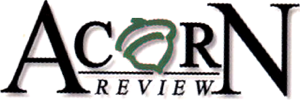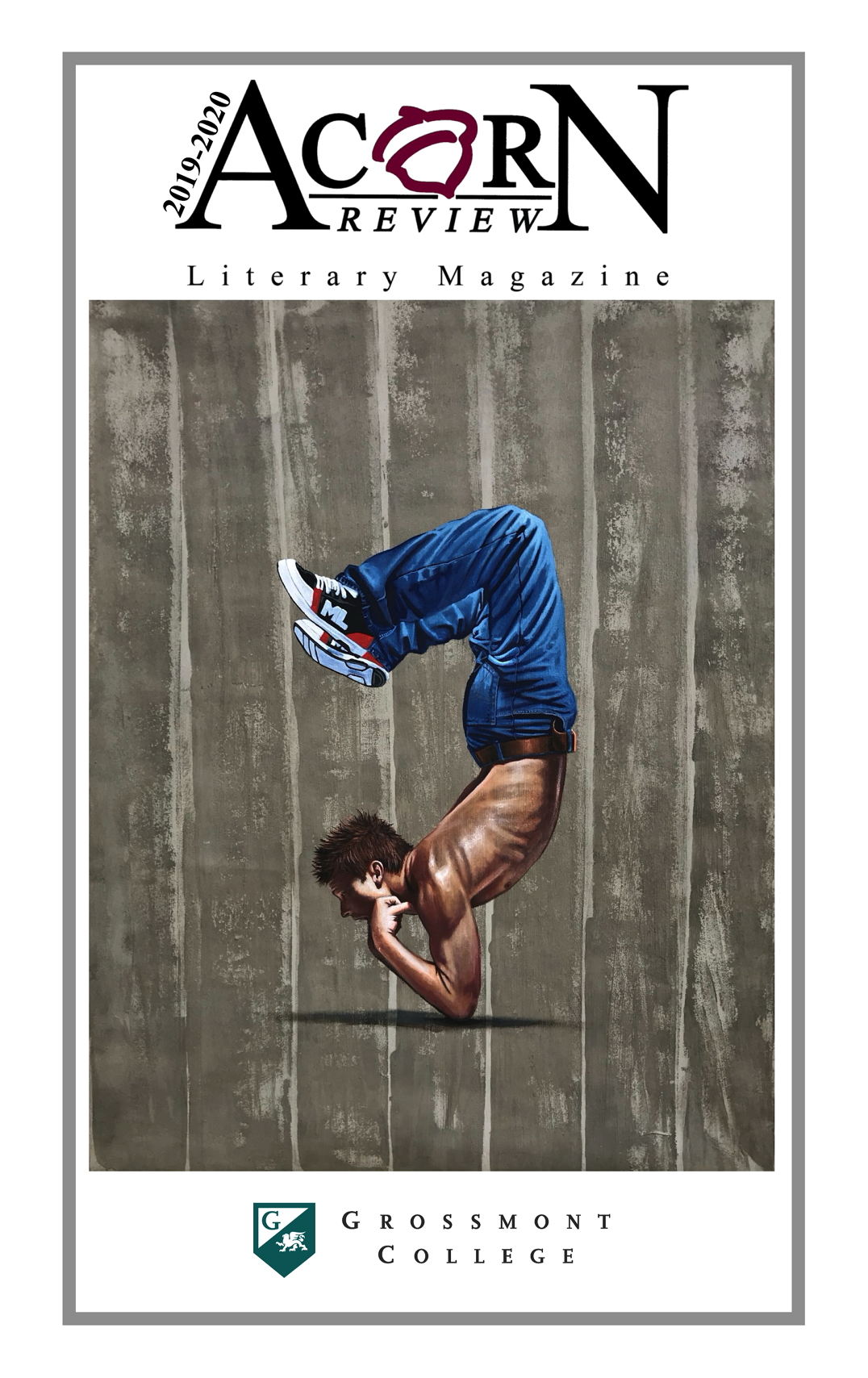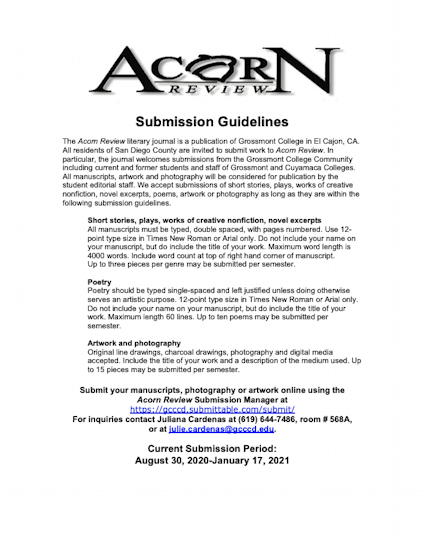Acorn Review Literary Journal
 grossmont.edu/acorn
grossmont.edu/acorn
Current Submission Period
July 30, 2024 through January 17, 2025
What is Acorn Review?
 The Acorn Review is Grossmont College's official literary arts journal, containing original student
writing and graphic arts. Under the advisorship of instructor Julie Cardenas, the
journal is edited and produced by students of English 145-148: Acorn Review, Editing
and Production. The journal is available for sale in the campus Barnes & Noble bookstore.
The Acorn Review is Grossmont College's official literary arts journal, containing original student
writing and graphic arts. Under the advisorship of instructor Julie Cardenas, the
journal is edited and produced by students of English 145-148: Acorn Review, Editing
and Production. The journal is available for sale in the campus Barnes & Noble bookstore.
Submissions are taken on a semesterly basis and may be submitted via the Acorn Review Submissions Manager—in the menu at left. More detailed information about the journal's beginnings, as well as its evolution, can be found below under "History of Acorn Review."
Submit to Acorn Review
The Acorn Review now accepts manuscripts through Submittable.com at gcccd.submittable.com/submit. Click below to link to the Acorn Review submissions manager and guidelines.
Submissions Guidelines
download a PDF of our submission guidelines
Cover Letter
In the "Cover Letter" field, provide us with a brief author bio, 50 words or less, using third person point of view.
Art Work
Up to 10 artwork pieces may be submitted by any one person during each submission period. All works must be titled and submitted separately. Submissions must be in jpg format. Artwork will be printed in black and white unless chosen for front or back covers.
Drama
Up to three pieces may be submitted in this category during a single submission period. The maximum word length for each manuscript is 4000. Each submission must be double-spaced using 12 point type size in either Arial or Times New Roman Font. All works must be titled and submitted separately. Do not include your name within the body or margins of your work.
Novel Excerpts
Up to three pieces may be submitted in this category during a single submission period. The maximum word length for each manuscript is 4000. Each submission must be double-spaced using 12 point type size in either Arial or Times New Roman Font. All works must be titled and submitted separately. Do not include your name within the body or margins of your work.
Creative Nonfiction
Up to three pieces may be submitted in this category during a single submission period. The maximum word length for each manuscript is 4000. Each submission must be double-spaced using 12 point type size in either Arial or Times New Roman Font. All works must be titled and submitted separately. Do not include your name within the body or margins of your work.
Short Stories
Up to three pieces may be submitted in this category during a single submission period. The maximum word length for each manuscript is 4000. Each submission must be double-spaced using 12 point type size in either Arial or Times New Roman Font. All works must be titled and submitted separately. Do not include your name within the body or margins of your work.
Poetry
Up to ten poems may be submitted by any one person during each submission period. The maximum line length for each poem is 60 lines. Poems must be single-spaced using 12 point type size in Arial or Times New Roman font. Poems should be left justified unless doing otherwise serves an artistic purpose. All poems must be titled and submitted separately. Do not include your name within the body or margins of your work.
History of Acorn Review
Grossmont College's legacy of literary journals began shortly after the college opened.
In 1963, English Department faculty members Chester H. Palmer and George Kirazian became faculty advisors to a short-lived but earnest project dedicated to student literary expression, named Talon Literary Magazine. Editors Bill Muerdter and Kurt Kuhwald made this statement in the literary magazine's first issue: "Colleges provide many means for student expression: scholastically, athletically, politically, etc. However, the artistic talents of a student body are often denied adequate display. It is the purpose of Talon to provide a media for expression in literature to students of Grossmont College. We hope you enjoy the stories, poems, and essays written by your fellow students." That initial issue of Talon Literary Magazine was a labor of love on a small budget, with a basic design layout and manually type-set contents. By the following year, Talon's production value had already begun to improve, but the glossy cover, professional typesetting, and full-page black-and-white photography inside would also be the magazine's swan song: by 1965, faculty advisor C.H. Palmer would leave Grossmont to become Dean of Instruction for El Centro College in Dallas, Texas, and by 1966 George Kirazian would begin filling his duties as Grossmont College's next English Department Chair. Student editor Kurt Kuhwald left to complete his degree at San Diego State College (he is now Reverend Kurt A. Kuhwald), and after Coast Guard veteran Bill Muerdter graduated and started a carpentry business, the baton of Talon's editorship would never pass to a next generation of students. It wouldn't be long, however, before another "adequate display" of Grossmont's artistic writing talents would find its medium for expression.
In January of 1969, Journalism instructor and campus newspaper editor Pat Higgins, with funding from the Communications Department and the English Department, challenged Journalism 124 students to create a literary supplement. The result was the newspaper insert, Impulse, featuring a collection of poems and short works of fiction generated by English students, alongside original drawings and artistic photographs. Grossmont's campus newspaper, The G (now The Summit), had no plans for repeat issues of Impulse, but the one-off project sparked vociferous response from The G's readers demanding more. The newspaper's editor-in-chief published the following statement in the 1969 year-end edition: "Because of numerous requests that another issue of 'Impulse' be produced this year, The G felt it would be appropriate to reserve eight pages of its final edition for this purpose. The following pages contain literary material contributed by students enrolled in Grossmont English classes." Impulse demonstrated, if nothing else, that there was a popular demand for a real campus literary arts periodical. In response, The G would sporadically publish a few more literary supplements, but none would bear the name "Impulse" again, nor would they be given their own periodicity like a regular serial publication.
Julie Cardenas still serves today as faculty advisor and has made considerable strides to transform the Acorn Review into one of San Diego east county's premier literary journals, all while keeping the integrity of its original mission: to offer as an exclusive showcase for our student writers and artists, and to serve as an unprecedented practicum for Grossmont Colleges students interested in literary editing and publishing. It would take another decade before public demand for a dedicated literary arts journal would be answered. In 1978, part-time English instructor Verena Anderson would begin advising the first editorial board for the brand new literary journal FirstDraft. Anderson's journal was an instant success, garnering enthusiastic and broad support from the Department, especially from her other colleagues in the now-growing Creative Writing Program: Ruth Anderson, Judith Barkley, Glenda Richter, and Stephanie Mood. Julie Cardenas, who joined the English Department faculty in 1993, took over the project when Verena Anderson retired in 1995. (Anderson passed away in 1999.) The journal continued being published under the name "FirstDraft" until the late 90s, when a campus-wide contest was held to give the journal's title a makeover. The winning submission came from Stephanie Mood, who recommended Acorn Review, chosen not only as a metaphor for the seeds of great talent but as a nod to the Kumeyaay Native Americans who populated the region.
Of course, the journal's title is not its only feature to have evolved over the years. Having originally featured primarily poetry, short fiction, and sketch art, the Acorn Review has since expanded its genres and content to include creative nonfiction, plays, and full-color art work and photography. Also, since taking over the position of faculty advisor in the mid 90s, Cardenas has championed the Acorn Review's format transformation from an 8.5 x 11 booklet with a Velo binding to a professionally bound cover-stock book with a glossy, full-color cover. When state budget cuts threatened to cancel Acorn Review classes, Cardenas and her students mobilized quickly to begin an official Acorn Review Club, which arranged to use regular Monday night meetings and the social media environment to conduct many of the same editorial functions as the class. Fortunately, English 145: Acorn Review continues to be offered as a "for credit" repeatable workshop, and writers across the campus always eagerly await the journal's next edition, but the Acorn Review Club also maintains its charter now as a campus student club. The journal has since inspired a popular four-course sequence of for-credit workshops, English 145 (146, 147, 148): Acorn Review, Editing and Publishing, which is now one of the centerpieces of our Creative Writing Program curriculum. Manuscripts and art works by Grossmont College students are submitted anonymously to an all-student editorial staff, who review them, then vote on pieces to select for inclusion in the next issue.
♠

